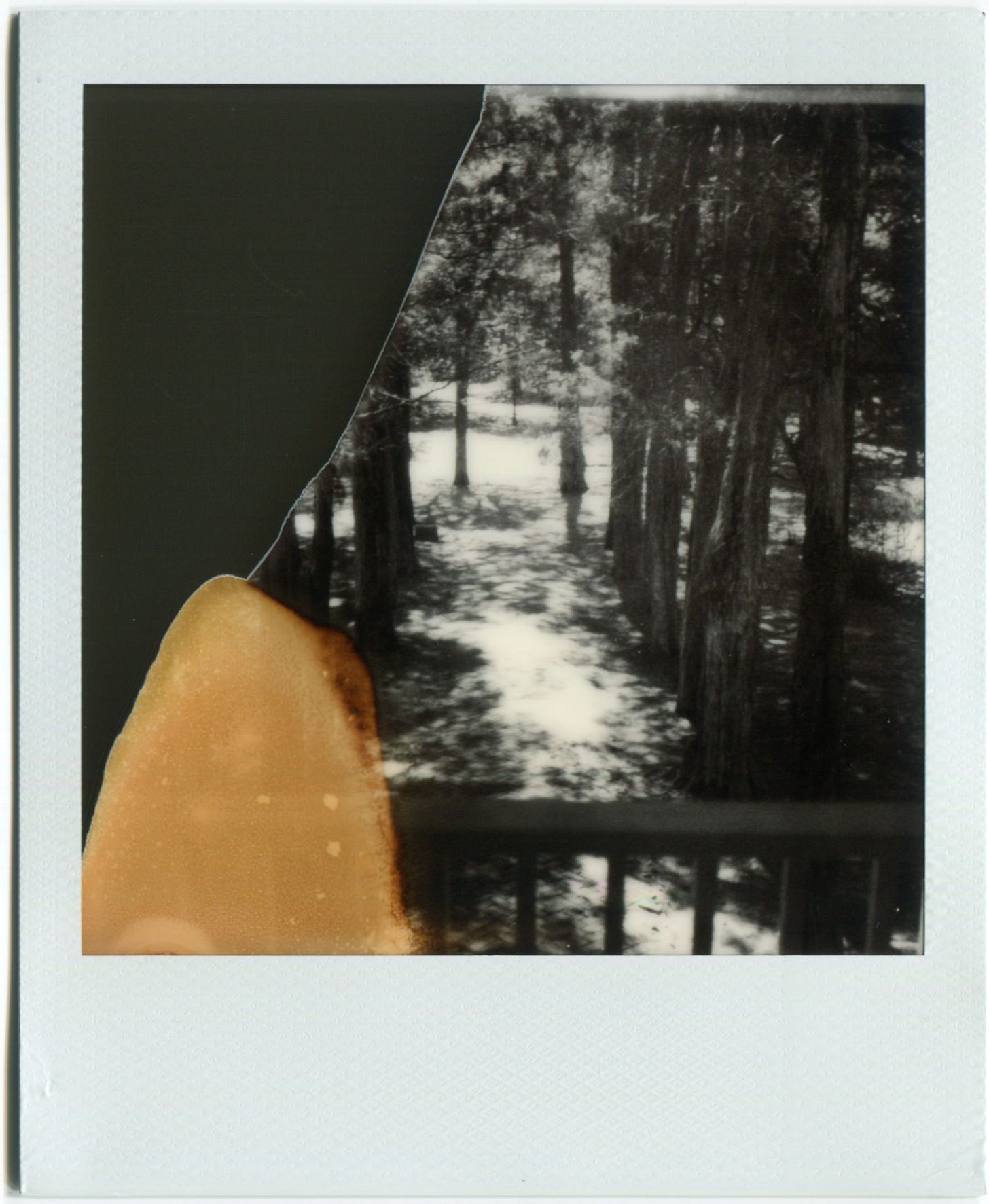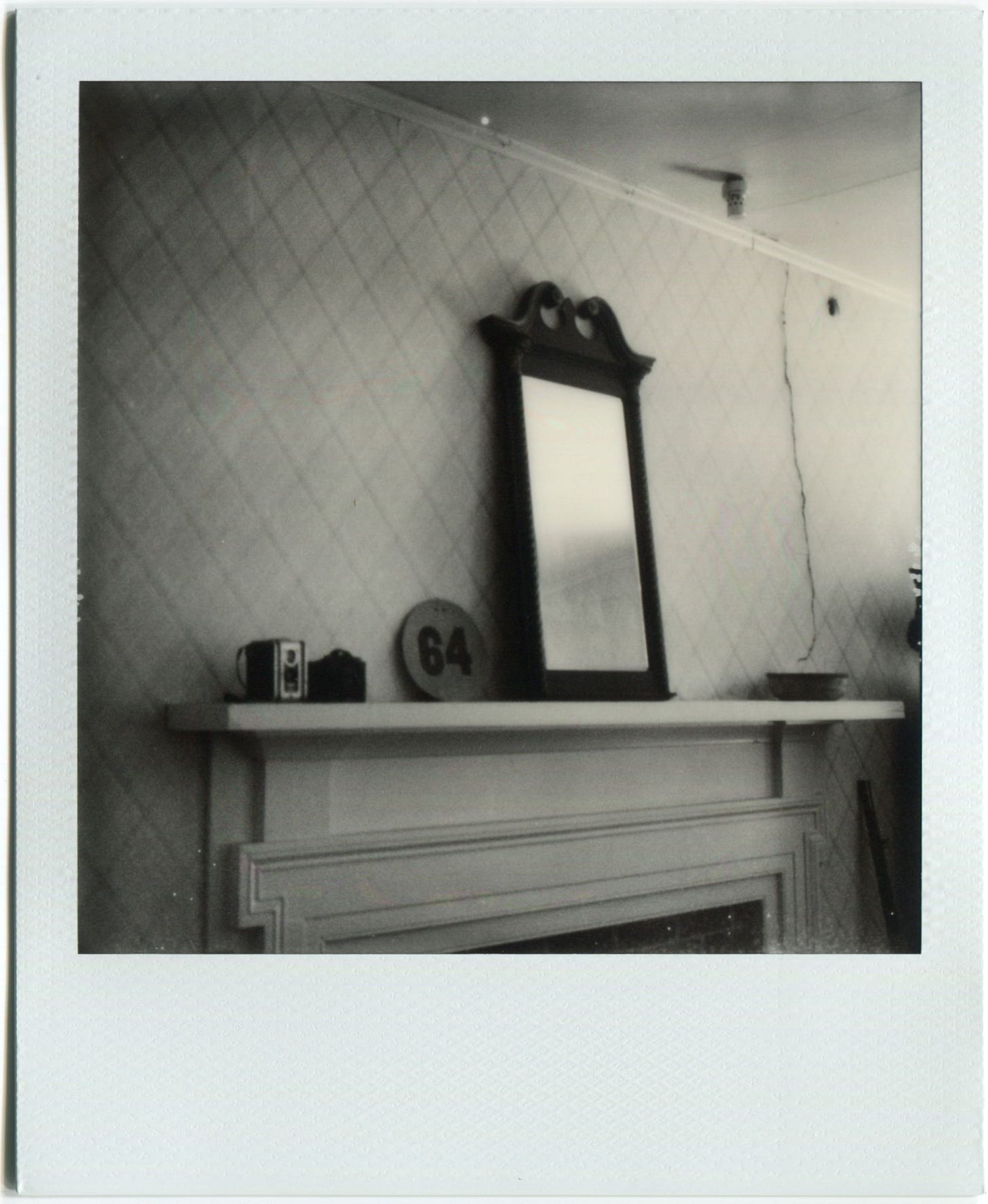We all kind of act like the six thousand the Old Man paid for the Bailey Place was nothing. First of all, y’all forget it was 1930 and nobody was buying much of anything at all, nobody could buy anything.
Plus the Old Man had already written five books and one of those was called The Sound and the Fury and the one after that was As I Lay Dying plus a whole lot of short stories which had run in some big newspapers and magazines. So it was more like The Times-Picayune or The Forum paid the six thousand.
And I guess third, if we’re still counting, the purchase came with somewhere around 30 acres of the land the Old Man loved most in the world. It wasn’t worth six thousand dollars to him; it was worth infinitely more.
View from the second story porch of Rowan Oak, Oxford, Mississippi, Polaroid SX-70 (all photos 2024)
That you can visit this sanctuary, and walk through it, and commune with the Old Man and his time, really is a miracle. I found myself in Oxford for work recently, and had already wandered by his grave early in the morning, which is when I like to visit. It had been years since I had been out to the house, and it was a beautiful spring day. I wondered what about it would seem different now.
His bedroom, looking left, Polaroid SX-70
Because I was different. The last time I had gone to the Old Man’s house was before I offered up my life’s savings for an acre in the middle of a city, for two live oaks, a gigantic magnolia, red clay, a cedar, two red oaks, a long-dead dogwood that would fall years later in a thunderstorm, two snakes coiled together in an azalea fifteen feet wide and seven feet tall, a house built in 1950 with brass doorknobs and built-in bookshelves, two large stands of gardenia which look dead half the year and then explode into emerald and ivory constellations come May, three red rose bushes, a bank of a half-dozen hydrangeas that bloom blue all summer through, a shed filled with half-empty paintcans and clad in rare Dutchlap, an attic which was curiously empty save a cheap full-length mirror. Before I began to dream about the crookneck squash coming in and that I needed to cut some bamboo from down by the creek for the pole beans.
As another Nobel laureate would put it, I was so much older then, I’m younger than that now.
His bedroom, looking up, Polaroid SX-70
Wait, where were we? I was looking out the window. I was doing the dishes. I was thinking about putting on Alive! by KISS. Side four is already on the turntable. Hold on, let me flip it over to start side three again, so I can end up at “Black Diamond.” Let me cut the mint back so it doesn’t crowd the blueberries, so I can muddle some up for my water. Let me remember we’re in waxing gibbous and the clouds won’t be as heavy tonight. Remind me to send a thank you to my Aunt Judy, for bringing me all the Wolfe birds I had given my Nana over the years, for the McCarty angel, bright white tinged with their special greenish-blue. What is a house but a collection of memories. What is a house. Six thousand dollars? Surely it’s not that.
His bedroom, his boots, looking down, Polaroid SX-70
All photography is a prayer, but Polaroid is a ritual. It is the spell of an urgent sorcerer. Sometimes it works and sometimes it doesn’t; wonderful, so you conjured a perfect color ‘69 Camaro in the bright sun at a street festival, now do hopping puppy in black and white, snag the pinks and purples of a Jackson sunset, the amber of a Delta sunrise, Harper Lee’s grave in searing overhead Alabama noon heatlamp.
Do Faulkner’s study, the crowd chants, and I begin to sweat even more, the fretboard already slick with effort, I mean that room is really dark, and there they go again, a guy in the front row just ripped his shirt off, mouthing “FABLE FABLE FABLE” over and again, his eyes squinted shut in ecstasy.
The Old Man’s study, where he would sleep, where he plotted out a novel one bleary night in 195x, he kept having to rewrite it and write it, it would be his masterwork, he hoped, Estelle had it repainted, so he wrote it again, but shellacked it this time, a spell by a Polaroid camera manuf. ca. 1975, cast 2024
I want to tell you that I almost saw his ghost, as a friend of mine was quite sure she almost did, could feel him echoing in the walls of that old wooden house, that six thousand dollar palace, but I keep looking out the window. The cardinals and towhees are singing, a robin in the birdbath, a woodpecker banging on oak somewhere in the distance, Paul Stanley yelling “HIT IT” in the living room. I need to build a trellis for the lima beans. I need some rocks for the path around the Japanese magnolia, I got that new paperback copy of Bill Egg’s The Outlands, it’s as big as a baby.
I don’t talk to the Old Man directly, you see, it would be ridiculous to say that I did, but I speak to him through the way we always talk to the past, through communion. Through walking around his house and tapping on his kitchen wall. Placing my foot on the gnarled foot of a magnolia out front, its roots spinning out like an octopus wild in the ocean.
I lean on one of the red cedars, and I gaze up at his house, and then I began to speak, and first a little nervous, and then I say:
The walkway of Rowan Oak, Polaroid SX-70
“SIX THOUSAND” is a chapter of GORJUS, a dispatch devoted to art and life in the South, held fast with instant film. The endless treasure of Rowan Oak is open to the public most days except Monday, and it’s only $5 (cash only). You can wander around the grounds and the woods for free; it’s worth your day, worth the drive, for the conversation.
If you liked what you saw and read, if you maybe felt a twang in your belly while you looked it over, then this is for you, and I reckon we would be friends. Consider sending this letter to a pal who is like us. I’m gorjusjxn on Instagram, and you can see an archive of Polaroids at McCartyPolaroids.









Poignant, thank you.
Twice I've whispered thank yous to Faulkner while walking his property and twice I've slipped / tripped/ fell seconds later.
“All photography is a prayer, but Polaroid is a ritual.”
i loved this so much